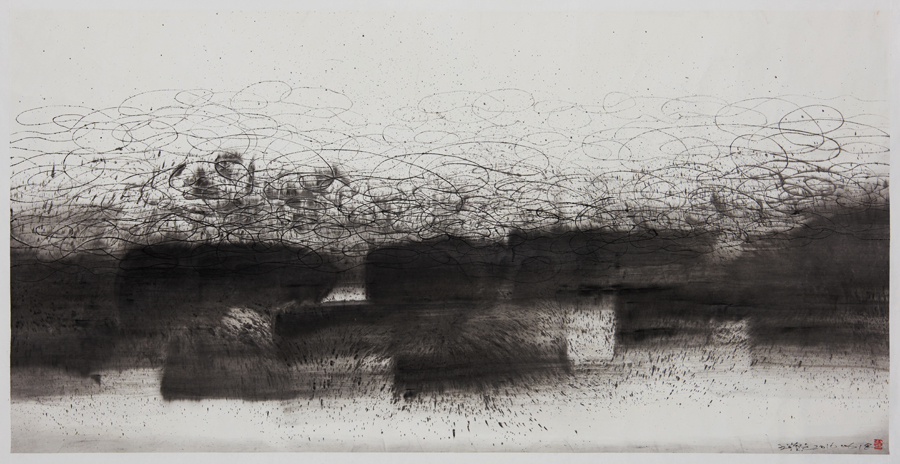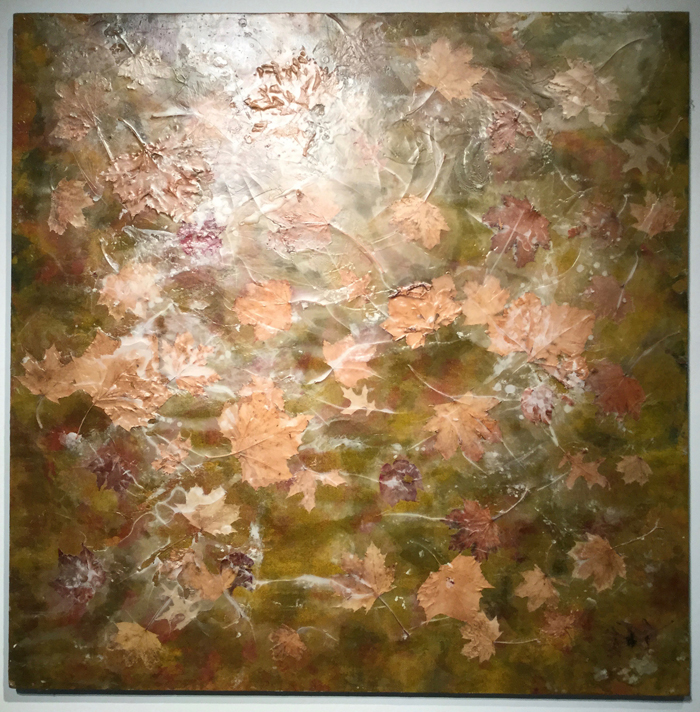
But this exhibition is not about recycled or transformed cardboard, paper made from wood pulp sketched with fine lines, or lovingly preserved natural materials. The keystone of the show is the eternal character of art. As one peruses the artworks, there are no social or political issues that challenge the mind or emotions, no sordid images that confront and confound one’s sensibilities. The show is pristine; its focus is on pure art. It resembles a museum venue in that it is outside the turmoil and upset of current issues.
As one contemplates the expressive potential of white paper, one begins to notice that shades of paper stir the imagination to conjure images of place: a sizzling mirage looming over a distant horizon, the endless cream sand dunes of the Sahara desert. White often evokes purity and cleanliness. In Native American cultures it has connections with Spirit.
Abstract art is elusive; one can never be sure if one’s interpretation parallels the artist’s intentions. Mahmoud Hamadani and Wang Huangsheng both employ delicate ink lines on paper, but their expressive strategies diverge manifestly. Oliver Catté and Alan Sonfist put their personal stamp respectively on cityscapes and on nature-based formats as they both explore their essential individuality. One senses a deep yearning in Sonfist to forge a unity between humanity and nature that is fast being forgotten.
Wang Huangsheng uses ink on paper to fluently create wafting lines whose confluence mirrors gusts of wind that can in some of the works suggest tornadoes in their early stages of development. His wayward lines find scope in circular pathways that maintain a musical surge, which seems to flow with the vagaries of his state of being. The irregular globules of ink play against thin clarity as the ink progresses over the paper. The works seem to signify turbulence or emotional upheaval; they are anything but static. These drawings have a playful sense of freedom, of loosely directed spontaneity in their execution.
.jpg) In his drawings Hamadani establishes definite horizontal and vertical structures composed of small circular-shaped “squiggles” that exude a sense of freedom and can be interpreted as signs of chaos in opposition to the organization in his compositions. “Fuzzy” lines in some of the works soften the essentially geometric forms, camouflaging their firm outlines. Hamadani at times employs a range of small to large poetic “dancing” calligraphic figures that balance the effect of his orderly forms. These finely wrought ciphers transport the mind to a visual realm that mirrors the pleasures of music. The marks vaguely resemble cuneiform figures of a highly personal script and offer to the viewer clues to the workings of his mind’s underlying topography. This is art that references itself, whose purpose is to express the inner necessity of the artist who creates it. It has little to do with worldly issues; instead, its beauty, its ultimate justification is the disclosure of the artist within.
In his drawings Hamadani establishes definite horizontal and vertical structures composed of small circular-shaped “squiggles” that exude a sense of freedom and can be interpreted as signs of chaos in opposition to the organization in his compositions. “Fuzzy” lines in some of the works soften the essentially geometric forms, camouflaging their firm outlines. Hamadani at times employs a range of small to large poetic “dancing” calligraphic figures that balance the effect of his orderly forms. These finely wrought ciphers transport the mind to a visual realm that mirrors the pleasures of music. The marks vaguely resemble cuneiform figures of a highly personal script and offer to the viewer clues to the workings of his mind’s underlying topography. This is art that references itself, whose purpose is to express the inner necessity of the artist who creates it. It has little to do with worldly issues; instead, its beauty, its ultimate justification is the disclosure of the artist within.
Oliver Catté transforms recyclable torn and refashioned corrugated cardboard into inspired imaginative cityscapes. These compelling dynamic works reverberate with the energy of the cities they recreate. The compositions are imbued with air, music, romance and life; Catte’s choice of cardboard as a material curbs the ultra-evocative expression of his lively personality. It prevents his art from becoming unduly picturesque. The pasty brown cardboard is converted into complicated engrossing tableaux. Catté’s brilliant regeneration of cardboard is achieved as if by legerdemain presenting the artist’s exceptionally lyric urban vision.
 Alan Sonfist’s Bronx background suggests childhood trips to city parks where nature intersects with the perimeters of urban spread. His work entitled “Leaves Frozen in time: Spring” (above) provides a glimpse into what appears to be the bottom of a pond seen through the patterns of leaves and traces of icy looking wax that float and amass on the surface. The piece is a view of nature’s changes as they move through the rhythms and fluctuations of the seasons. The desire to preserve natural materials seems to stem from an inner drive to control time, or the recurring cycles it represents. If we cannot stop time passing, at least we can keep nature’s cast-offs, the seasonal remnants of time past. Sonfist attempts to conserve nature by keeping its byproducts and markings. By rubbing charcoal over paper affixed to a tree, he has reproduced patterns of birch bark. Rubbings are by nature quite faint, but the pattern is discernable.
Alan Sonfist’s Bronx background suggests childhood trips to city parks where nature intersects with the perimeters of urban spread. His work entitled “Leaves Frozen in time: Spring” (above) provides a glimpse into what appears to be the bottom of a pond seen through the patterns of leaves and traces of icy looking wax that float and amass on the surface. The piece is a view of nature’s changes as they move through the rhythms and fluctuations of the seasons. The desire to preserve natural materials seems to stem from an inner drive to control time, or the recurring cycles it represents. If we cannot stop time passing, at least we can keep nature’s cast-offs, the seasonal remnants of time past. Sonfist attempts to conserve nature by keeping its byproducts and markings. By rubbing charcoal over paper affixed to a tree, he has reproduced patterns of birch bark. Rubbings are by nature quite faint, but the pattern is discernable.
The abstract works on view represent the crux of human feeling, which in drawing is arguably the sense of touch. They are pure expressions that for all intents and purposes lack reference to the world and its upheavals. Clearly the artists’ minds are not focusing on controversial issues, which would have been a way to raise their voices with dissent. While abstraction is timeless, it occasionally needs to be tweaked and updated.
